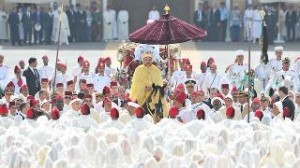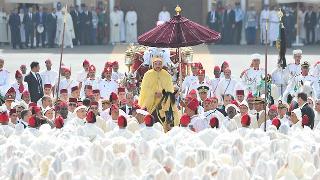 WHY hasn’t Morocco had an Arab Spring? On the one hand, history; on the other, the vision of its monarch, King Mohammed VI.
WHY hasn’t Morocco had an Arab Spring? On the one hand, history; on the other, the vision of its monarch, King Mohammed VI.
Throughout the colonial era, when France and Spain each had a slice of the country, Morocco retained its identity, its cities, culture and monarchy, which stretched back centuries, unlike the artificial monarchies created in the Middle East by the Europeans. It was never officially a colony of either France or Spain, but a protectorate.
France did exile Mohammed V, the present king’s grandfather; but in 1956 the people successfully demanded his restoration, and full independence followed in 1957. So Morocco is the only country whose people have successfully campaigned for the return of a ruler who pre-dated colonialism.
Mohammed VI succeeded to the throne in 1999 and swiftly began a series of reforms that have allowed him to leapfrog the Arab Spring. The present government is headed by an Islamist party, in coalition with three of the parties of the previous government, and the king has devolved power to that administration in all but two crucial areas. As a direct descendant of the Prophet, he retains his position as head of the religion; and, like the US president, he remains commander-in-chief of the armed forces.
While the foresight of the king has brought much stability to the country, corruption, although considerably reduced in recent years, continues to be a concern. The king has too many cars, and some of his relatives behave in an unattractive manner.
But the mass of the people support the direction in which the country is moving (see footnote).
While his father, a potentate, was feared, Mohammed VI is loved. But up in Tangier, where my grandfather settled in the 1920s, the enormous and uncontrolled development, which has left many back pockets bulging, is very worrying. King Hassan hated Tangier and for the 38 years of his reign the city mouldered.
But King Mohammed’s ambition is that Tangier should rival Algeciras as an import and export hub. There is a new port outside the town, motorways and thousands of blocks of flats, as well as hundreds of tourist complexes of the worst kind. There are worries about how the city will provide sufficient water and services.
The beautiful wild iris, Iris tingitana, which used to turn the hills blue in spring, is scarcely to be seen. There are wonderful new traffic lights in Tangier. They count you down in seconds, and if you are a pedestrian, the little man in green runs faster and faster as the time for crossing runs out. There is a game played at roundabouts, called “Can you guess which exit I will take?” The winner is the driver who decides last, crosses most lanes of traffic, and manages not to touch another car. Anyone who uses indicators is disqualified.
To the expatriate community, particularly the British, it was a surprise in 2002 when a Dubai-based tycoon decided to build a cricket stadium adjoining the golf club of Tangier. As far as anyone can remember, no cricket had ever been played in Morocco. The idea was to have a neutral location for international cricket, one that would be attractive to television companies: good climate and time zone. But there was one element missing – spectators. The first match attracted a few mystified elderly Brits and a smattering of Moroccans who thought they were going to see a baseball match.
The last time the cricket pitch (which is still watered and mowed) was used was in 2004. One can only hope that the new Islamic government in Morocco will change the habit of giving permits for all these rich men’s follies.
Tessa Codrington
m.theaustrailian.com.au







